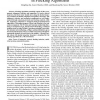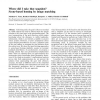1410 search results - page 266 / 282 » Mobile Robots and Intelligent Environments |
TFS
2008
13 years 7 months ago
2008
Abstract--Flocking algorithms essentially consist of three components: alignment, cohesion, and separation. To track a desired trajectory, the flock center should move along the de...
BC
1998
13 years 7 months ago
1998
In homing tasks, the goal is often not marked by visible objects but must be inferred from the spatial relation to the visual cues in the surrounding scene. The exact computation o...
WACV
2007
IEEE
14 years 1 months ago
2007
IEEE
Visual categorization is fundamentally important for autonomous mobile robots to get intelligence such as novel object acquisition and topological place recognition. The main difļ...
AOSE
2004
Springer
14 years 1 months ago
2004
Springer
While there are many useful models of agents and multi-agent systems, they are typically deļ¬ned in an informal way and applied in an ad-hoc fashion. Consequently, multi-agent sys...
NEUROSCIENCE
2001
Springer
14 years 4 days ago
2001
Springer
This volume is intended to help advance the ļ¬eld of artiļ¬cial neural networks along the lines of complexity present in animal brains. In particular, we are interested in examin...


